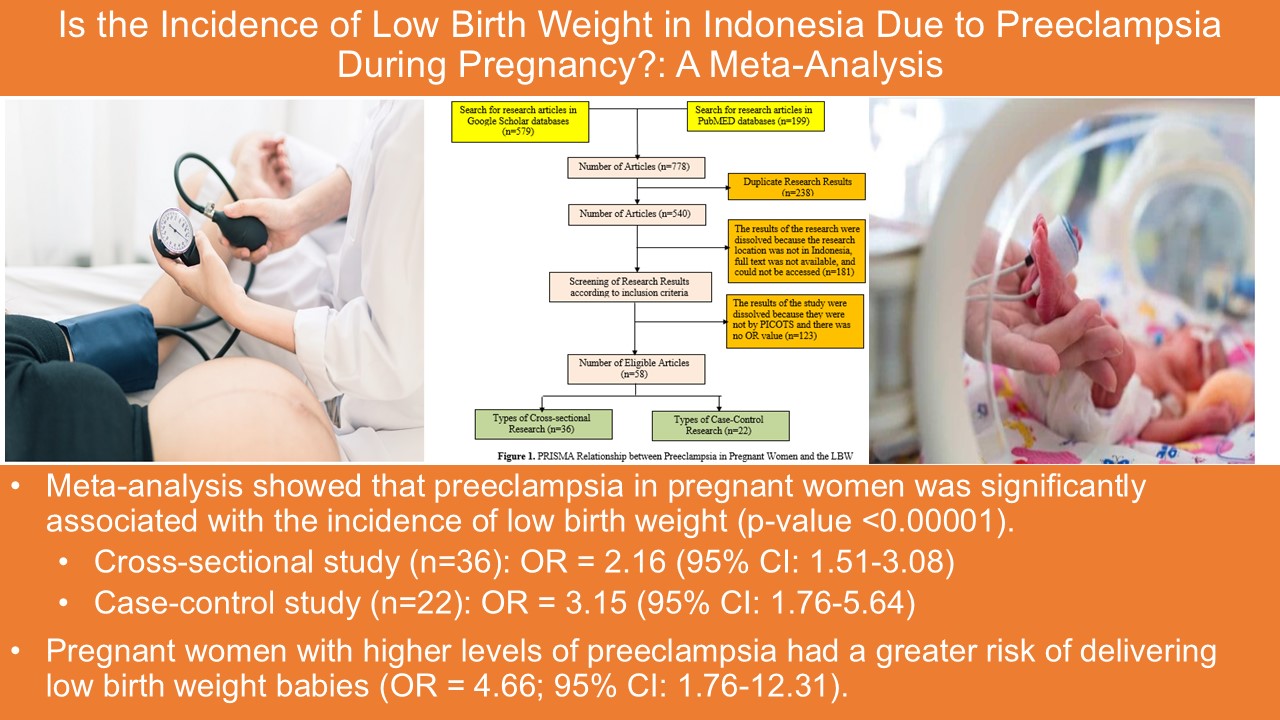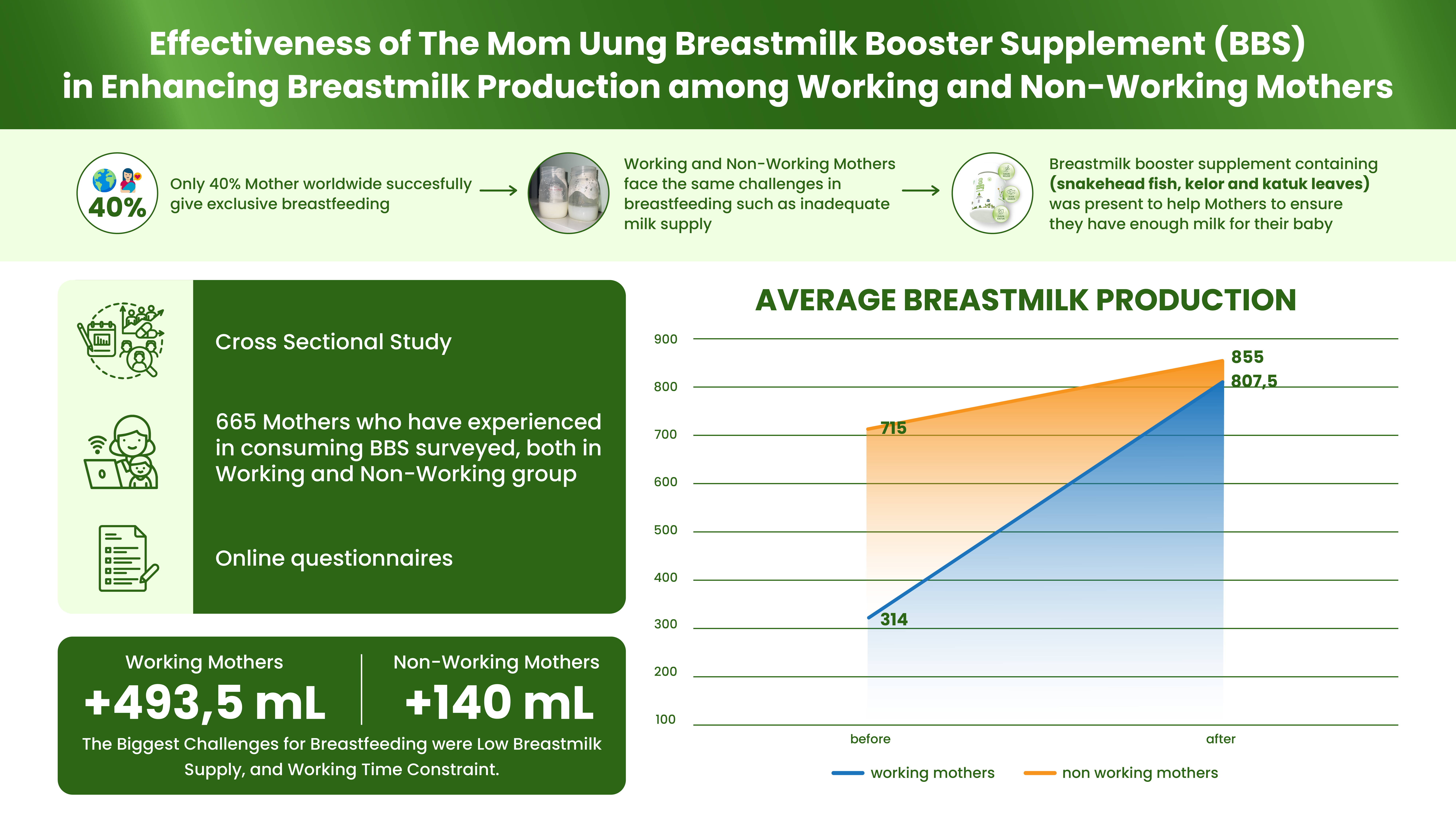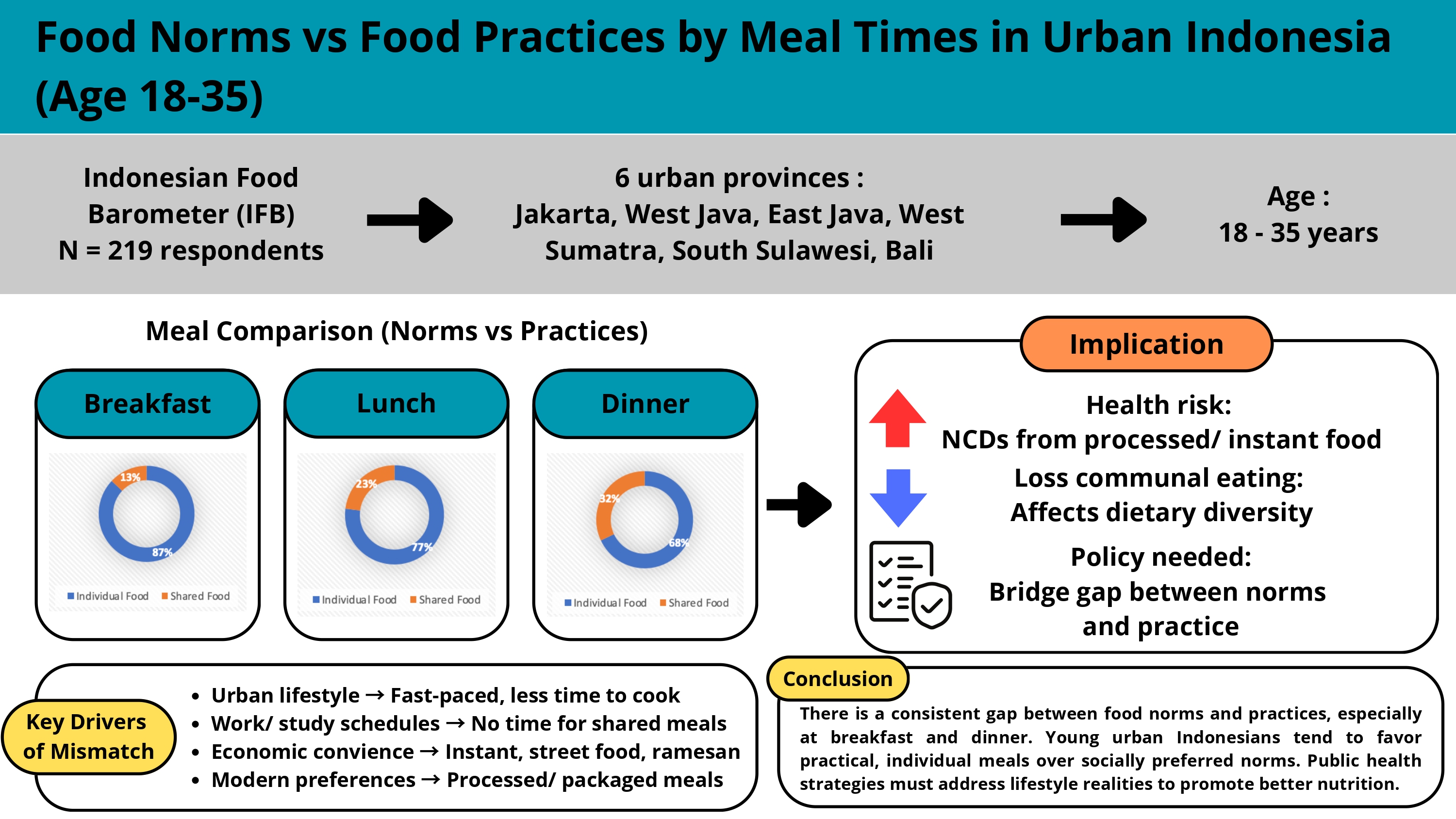SENSORY ANALYSIS OF INSTANT COMPLEMENTARY FOOD WITH FERMENTED EGG FLOUR SUBSTITUTION AS A SOURCE OF PROTEIN AND SELENIUM IN STUNTING CHILDREN

Downloads
Childhood stunting is a health problem associated with chronic malnutrition, particularly inadequate protein and selenium intake. Fermented egg flour was chosen because the fermentation process can increase the bioavailability of protein and selenium. This study aimed to develop and evaluate the sensory quality of instant complementary food formulated with fermented egg flour as a source of protein and selenium. The nutritional composition of this formulation has been reported in a previous study; therefore, this research specifically focuses on its sensory evaluation. The sensory test was conducted using a 9-scale hedonic method on the parameters of taste, aroma, texture, and color involving 66 semi-trained panelists (nutrition students). The research method used a completely randomized design (CRD) with four formulations: F0 (control) and F1, F2, and F3 as treatments with 10, 15 and 20% fermented eggs, respectively. Data analysis used one-way ANOVA and Kruskal-Wallis tests (p<0.05). The test results showed that the substitution of fermented egg flour had a significant effect on panelists' preferences in the aspects of color, taste, and aroma but not significant in texture; the protein content from 20.56% to 20.59%, 21.68%, and 22.54%, along with an increase in energy content from 417 kcal to 419 kcal, 427 kcal, 431 kcal in instant complementary food. However, higher fermented egg flour proportions reduced acceptance due to a fishy aroma.
Ahmad, S., M. Yousaf, and M. Khan. 2018. “Effect of hot air convective drying on sugar composition of chestnut (Castanea sativa Mill.) slices.” Journal of Food Processing and Preservation 42(4). https://doi.org/10.1111/jfpp.13567
Amagloh, F. K. 2022. “Sweetpotato-Based Infant Foods Produce Porridge with Lower Viscosity and Aflatoxin Level than Cereal-Based Complementary Blends.” PLoS ONE 17(10 October):1–11. https://doi.org/10.1371/journal.pone.0275593.
Babys, I Y, Y. L. R. Dewi, and S. S. Rahardjo. 2022. “Meta-Analysis the Effect of Complementary Feeding Practice on Stunting in Children Aged 6-59 Months.” Journal of Maternal and Child Health 7(4):465–78. https://doi.org/10.26911/thejmch.2022.07.04.10.
Black, R. 2013. “Maternal and Child Undernutrition and Overweight in Low-Income and Middle-Income Countries.” The Lancet. 382(9890):427-51. https://doi.org/10.1016/S0140-6736(13)60937-X
Dalamin, N.S., and WK Solomon. 2016. “Effect of Ingredients Ratio on Physicochemical and Sensory Properties of Sorghum, Maize and Soya Protein Concentrate Blend Extrudates.” International Journal of Food Sciences and Nutrition Engineering 112–20. http://dx.doi.org/10.5923/j.food.20160605.02.
Depkes RI. 2018. “Laporan Riskesdas 2018 Nasional.Pdf.” Lembaga Penerbit Balitbangkes 156.
Dewi, S.K., F. R. Fadhila, Nuryanto, A.Margawati 2024. “Physicochemical Properties of Instant MP-ASI with Fermented Egg Flour as an Alternative to Fulfill Protein and Selenium Intake for Stunted Children.”
Dita K., A. Herminiati, N. Yuliantika. 2021. “The Physicochemical Properties of Mocaf-Based Baby Instant Porridge by Tempeh Four Subtitution Toward Skim Milk as a Protein Source.” Jurnal Riset Teknologi Industri 15(1):12–22.
Fadhila, F. R., Nuryanto, Ani Margawati, N. Rustanti, and F. Ayustaningwarno. 2024. “Potential of Fermented Eggs For Stunting Prevention: Literature Review” https://ejournal2.undip.ac.id/index.php/jaft/article/view/25638
Fitriani, S., and Y. Kusumawaty. 2011. “Kajian Proses Produksi Dan Tingkat Kesukaan Konsumen Terhadap Mi Sagu Tradisional Riau.” 10(1), 42–48. https://ejournal.kompetif.com/index.php/dayasaing/article/view/1572
Fox, P. F., and P. L. H. McSweeney. 2015. “Dairy Chemistry and Biochemistry.” Springer. https://doi.org/10.1007/978-3-319-14892-2.
Gantois, I., R. Ducatelle, F. Pasmans, F. Haesebrouck, R. Gast, J. Dewulf, and F. Van Immerseel. 2009. “Mechanisms of Salmonella Contamination in Eggs: A Review.” Food Research International 42(7),935–48. https://doi.org/10.1016/j.foodres.2009.04.004.
Kadita. 2016. “Kadar Serum Selenium Pada Remaja Akhir Usia 17-19 Tahun Berdasarkan Status Obesitas Dan Stunting.” Journal of Nutrition College, 4(5):360–67. https://ejournal3.undip.ac.id/index.php/jnc/article/view/22279
Kemenkes RI. 2022a. “Kemenkes RI No HK.01.07/MENKES/1928/2022 Tentang Pedoman Nasional Pelayanan Kedokteran Tata Laksana Stunting.” Kementerian Kesehatan Republik Indonesia 1–52.
Kemenkes RI. 2022b. “Status Gizi SSGI 2022.” BKPK Kemenkes RI 1–156.
Kemenkes RI. 2023. “Survei Kesehatan Indonesia (SKI) 2023.” Badan Kebijakan Pembangunan Kesehatan.
Khairani. 2020. “Situasi Stunting Di Indonesia.” Data Dan Informasi Kesehatan 208(5):1–34.
Kim, H. J., S. Y. Lee, and K. H. Park. 2020. “Role of Sulfur Compounds and Amino Acids in Umami Perception of Fermented Foods.” Journal of Food Science 85(3), 512–20.
Lee, H., Y. Kim, and J. Park. 2020. “Role of Dairy Proteins in Modulating Volatile Profiles of Processed Foods.” Food Chemistry 310, 125857.2020.125857. https://doi.org/10.xxxx/foodchem.
Li, M., J. Zhang, and Y. Xu. 2021. “Influence of Oil Addition on the Sensory Properties of Reconstituted Powdered Foods.” Food Research International 143, 110245.
Liang, N., X.M. Chen, and D.D. Kitts. 2018. “Sugar Loss Attributed to Non-Enzymatic Browning Corresponds to Reduce Calories Recovered in Low-Molecular-Weight Fraction.” Journal of Nutrition & Food Sciences 08(02). https://doi.org/10.4172/2155-9600.1000674.
Listyoningrum, H, and Harijono. 2017. “Optimasi Susu Bubuk Dalam Makanan Pendamping ASI (MP-ASI ).” Jurnal Pangan Dan Agroindustri 3(4):1302–12.
Liu, Y., J. Huang, and X. Zhang. 2019. “Effect of PH on Maillard Reaction and Nutritional Loss in Processed Foods.” International Journal of Food Chemistry 285, 125-135. https://doi.org/10.1016/j.foodchem.2019.02.015.
Luque, V., R. Closa-Monasterolo, J. Escribano, and N. Ferré. 2015. “Early Programming by Protein Intake: The Effect of Protein on Adiposity Development and the Growth and Functionality of Vital Organs Supplementary Issue: Parental Nutritional Metabolism and Health and Disease of Offspring.” Nutrition and Metabolic Insights 8(S1):49–56. https://doi.org/10.4137/NMI.S29525.TYPE.
Lutter, C. K., B. L. Caswell, C. D. Arnold, Lora L. Iannotti, K. Maleta, R. Chipatala, E. L. Prado, and C. P. Stewart. 2021. “Impacts of an Egg Complementary Feeding Trial on Energy Intake and Dietary Diversity in Malawi.” Maternal and Child Nutrition 17(1):1–11. https://doi.org/10.1111/mcn.13055.
Masturoh I, and N. Anggita. 2018. “Metodologi Penelitian Kesehatan.” Jakarta: Kementerian Kesehatan Republik Indonesia
Mine, Y. 2008. “Egg Bioscience and Biotechnology.” John Wiley & Sons.
Muhammad, A. I., D. A. A. Mohamed, L. T. Weed, and A. A. Samsudin. 2021. “Effect of Sodium Selenite, Selenium Yeast, and Bacterial Enriched Protein on Chicken Egg Yolk Color, Antioxidant Profiles, and Oxidative Stability.” Foods (Basel, Switzerland), 10(4): 871. https://doi.org/10.3390/foods10040871
Putri, Y. I., S. Anwar, D. N. Afifah, E. Chasanah, Y. N. Fawzya, and P. Martosuyono. 2019. “Optimasi Formula MP-ASI Bubuk Instan Sumber Protein Dengan Subtitusi Hidrolisat Protein Ikan (HPI) Dan Tepung Kacang Hijau Menggunakan Response Surface Methodology (RSM).” Jurnal Aplikasi Teknologi Pangan 8(4):123. https://doi.org/10.17728/jatp.4346.
Rahman, M. M., M. I. Hossain, and S. Ahmed. 2020. “Pengaruh Suhu Pengeringan Terhadap Warna Dan Karakteristik Sensoris Produk Pangan.” Journal of Food Processing and Preservation 44(3), e14356.
Rahman, M.T., Md. A. Zubair, K. Shima, and M. P. Chakma. 2020. “Development of Quality Parameters for Yogurt with Strawberry Juice.” Food and Nutrition Sciences 11(12):1070–77. https://doi.org/10.4236/fns.2020.1112075.
Rayman, M. P. 2012. “Selenium and Human Health.” The Lancet 379(9822), 1256–68. https://doi.org/10.1016/S0140-6736(11)61452-9.
Sharma R, P. Garg, P. Kumar, S.K. Bhatia, and S. Kulshrestha. 2020. “Microbial Fermentation and Its Role in Quality Improvement of Fermented Foods.” Fermentation Nov 6;6(4):106.
Sharma R, and P. Kumar. 2020. “Role of PH Adjustment in Protein Stability and Food Processing.” Journal of Food Science and Technology 57(4), 1125–32. https://doi.org/10.1007/s13197-020-04405-9.
Smith, J., and R. Simpson. 2021. “Volatile Compounds in Dairy-Based Food Systems: Influence on Aroma and Sensory Characteristics.” Journal of Dairy Science 104(7), 4567–78. https://doi.org/10.xxxx/jds.2021.4567.
SNI. 2005. “Makanan Pendamping Air Susu Ibu (MP-ASI)-Bagian 1 : Bubur Instan.” Badan Standardisasi Nasional 1–14.
Song, Y., S. ]. Cho, J. Park, and C. Lee. 2021. “Effect of Drying Methods on the Microbial Safety and Quality Characteristics of Powdered Egg Products.” LWT - Food Science and Technology 145, 111589. https://doi.org/10.1016/j.lwt.2021.111589.
Sukmawati, Sukmawati, A. Pakri, and R. Ismail. 2019. “Daya Terima, Karakteristik Fisik Kimia MP-ASI Tepung Beras Merah Dan Tepung Kedelai Pencegahan Stunting.” Media Gizi Pangan 26(1):112. https://doi.org/10.32382/mgp.v26i1.1003.
Tamang, J. P., K. Watanabe, and W. H. Holzapfel. 2016. “Review: Diversity of Microorganisms in Global Fermented Foods and Beverages.” Frontiers in Microbiology 7, 377. https://doi.org/10.3389/fmicb.2016.00377.
UNICEF, WHO, and World Bank Group. 2021. “Levels and Trends in Child Malnutrition: Key Findings of the 2021 Edition of the Joint Child Malnutrition Estimates.”
Utami, P. 2008. “Sifat Organoleptik, Overrun, Dan Daya Terima Es Krim Yang Dibuat Dari Campuran Susu Kedelai Dan Susu Sapi Dengan Perbandingan Yang Berbeda.”
Wahyuni, T. 2023. “Tingkat Kesukaan Dan Kandungan Zat Gizi Sosis Ikan Nila ( Oreochromis Niloticus ) Dengan Penambahan Tepung Jamur Tiram Putih ( Pleurotus Ostreatus ).” Skripsi.
Wang, X., et al. 2021. “Functional Properties of Egg White Proteins and Their Applications.” Food Chemistry 350, 128646. https://doi.org/10.1016/j.foodchem.2021.128646.
Wang, T., L. Zhao, and X. Chen. 2021. “Influence of Acidification on Egg Protein Functionality in Food Applications.” Food Hydrocolloids 118, 106739. https://doi.org/10.1016/j.foodhyd.2021.106739.
Wongpornchai S., K. Dumri, S. Jongkaewwattana and B. Sin. 2004. “Effects of Drying Methods and Storage Time on The Aroma and Milling Quality of Rice (Oryza Sativa L).” (Food Chemistry):87-407–14.
World Health Organization (WHO), UNICEF, and The World Bank. 2023. “Nutrition and Food Safety.” Joint Child Malnutrition Estimates (JME).
Wulandari Z. and I. I. Arief. 2022. “Review: Tepung Telur Ayam: Nilai Gizi, Sifat Fungsional Dan Manfaat.” Jurnal Ilmu Produksi Dan Teknologi Hasil Peternakan 10(2):62–68. https://doi.org/10.29244/jipthp.10.2.62-68.
Yanti, N. D, F. Betriana, and I. R. Kartika. 2020. “Faktor Penyebab Stunting Pada Anak: Tinjauan Literatur.” REAL in Nursing Journal 3(1):1. https://doi.org/10.32883/rnj.v3i1.447.
Zhao, X., J. Wang, and H. Chang. 2019. “Effects of Drying Temperature on Volatile Compounds in Fermented Egg-Based Products.” Food Chemistry 285, 256-64.
Zuyyin, and Nurul Millatina. 2013. “Analisa Zat Pewarna Alami Pada Daun Pandan Wangi (Pandanus Amaryllifolius) Dan Daun Pandan Suji (Dracaena Angustifolia) Menggunakan Spektrofotometer (Analysis Uncertified Color Substance On Pandanus Wangi Leaves (Pandanus Amaryllifolius) And Pandanus Suj.” Tesis UNDIP.

This work is licensed under a Creative Commons Attribution-NonCommercial-ShareAlike 4.0 International License.
- MEDIA GIZI INDONESIA Journal is the copyright owner of all materials published on this website.
- The formal legal provisions for access to digital articles of this electronic journal are subject to the terms of the Creative Commons Attribution-NonCommercial-ShareAlike license (CC BY-NC-SA 4.0), which means that MEDIA GIZI INDONESIA Journal and readers reserve the right to save, transmit media / format, manage in database, maintain, and publish articles as long as it continues to include the name of the Author.
- Printed and published print and electronic manuscripts are open access for educational, research and library purposes. In addition to these objectives, the editorial board shall not be liable for violations of copyright law.


2.png)





















